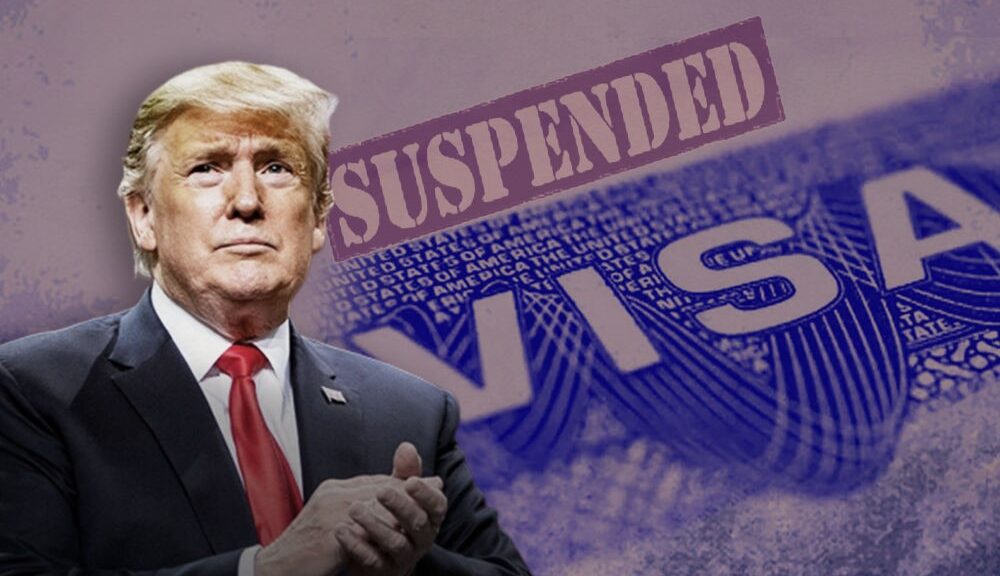
The Trump Administration Reforms H-1B Visa Program
Post by Yoonjon Lee. Colgate Class of 2022.
One of the most salient effects of the COVID-19 pandemic has been the drastic changes in the U.S. labor market. Unemployment spiked to 14% in April and currently remains at 7%[1]. In response to these changes, and in lieu with campaign promises, the Trump administration began producing policies that target immigration into the United States, specifically high skilled workers, through its temporary suspension of H-1B visas[2] effective since June. The underlying reasoning behind this suspension was that in times of severe economic downturn, the United States must prioritize native workers before it can admit foreign workers who compete with the native population for jobs.[3]
On Tuesday, October 5th, the Trump administration outlined the specific reforms that it would be making to the U.S. H-1B visa program. First, employers who are sponsoring these visas will now have to pay foreign workers – at minimum – the 45th percentile for entry-level and 95th percentile for high-level positions of each respective distribution of wages. This effectively forces firms to pay a “premium” for hiring foreign-born workers over native ones. Another significant change is that visa applicants will now only be able to apply for visas in industries that relate to their college degree, which means that the best qualified applicant for a job may be denied on the basis of her having taken a unrelated major in college. The Departments of Homeland Security and Labor announced that these reforms will lead to a third of H-1B visa applications being rejected.[4] But do these new reforms target the underlying reasons for unemployment, or will it just do more harm than good?
The Nature of H-1B Visa Immigrants and their Function in the U.S. Economy
The administration is creating a price-premium on foreign labor for American firms because it is convinced that companies are selecting cheap foreign labor over fair-priced American labor through H-1B visa sponsorship.[5] However the significant majority of H-1B visa recipients are highly skilled workers who are non-replaceable by the domestic workforce and has already been earning, on average, more than their American counterparts within the same positions, years of experience, and industries.[6] In other words, firms hire foreign workers because the domestic talent pool does not meet their demands and they already pay a premium for foreign labor.
Another issue is that, if the visa reform is truly about protecting American jobs by cutting foreign employment, simply making the qualifications for sponsorship more restrictive will not likely change the amount of high skilled workers employed.[7] This is because the United States already faces an extraordinary over-demand for H-1B visas. The current quota is set at 85,000 a year, but the government receives far more applicants than it can take in. The new restrictions might lead to more rejection rates and sub-optimal labor market conditions,[8] but it will presumably not lessen the actual amount of jobs taken by foreign born workers each year.
Conclusion and Relating Policy to Neoclassical Model
An overwhelmingly large body of research and literature continues to reinforces the idea that high-skilled immigrants in the United States not only increase firms productivity directly, but also have positive “spill-over” effects to their native workers.[9]
Under the theory of the neoclassical model of migration, the visa reform will actually hurt U.S. firms in terms of productivity, innovation, and competitiveness by creating sub-optimal labor market conditions (i.e. the best qualified may not actually be selected) and discouraging foreign talent from coming into the United States. The latter consequence can be explained by the fact that more restrictions on immigration by high-skilled workers will not only increase migration costs, but also affect the probability of future employment and thus individual job security. For migrants who are forward thinking and looking to commit to migrating permanently, such restrictions from the United States may discourage them and force them to look at alternative destinations such as Canada and Australia.
Finally, high unemployment during the pandemic may be better explained by the fact that consumption has decreased significantly and that prospects of starting new businesses are bleak given the current situation.[10] Protecting American jobs by restricting high-skilled workers neither targets the fundamental issue of the current U.S. economy nor does it even give native workers a better chance of employment in a specialized market that most of them do not even qualify for.
[1] “United States Unemployment Rate | 1948-2020 Data | 2021-2022 Forecast | Calendar.”
[2] Visa that allows U.S. employers to temporarily employ highly specialized foreign workers
[3] Hackman, “Trump Administration Announces Overhaul of H-1B Visa Program.”
[4] Ibid.
[5] Ibid.
[6] Ruiz, “H-1B Visas and the STEM Shortage.”
[7] Hackman, “Trump Administration Announces Overhaul of H-1B Visa Program.”
[8] Bernstein, Brown, and Brown, “Immigrant Entrepreneurship: An American Success Story,” p.10.
[9] Ibid, p.6-7.
[10] O’Donnell, “Ten Facts about COVID-19 and the U.S. Economy.”
Work Cited
Abhishek, M. “The Trump Administration will Suspend H-1B Visas.” Image. The Logical Indian, June 23, 2020. https://thelogicalindian.com/news/us-suspends-h1b-visa-21849
Bernstein, Shai, Ashley Brown, and Gregory Brown. “Immigrant Entrepreneurship: An American Success Story.” Kenan Institute of Private Enterprise/National Venture Capital Association, May 31, 2019.
Hackman, Michelle. “Trump Administration Announces Overhaul of H-1B Visa Program.” Wall Street Journal, October 7, 2020, sec. Politics. https://www.wsj.com/articles/trump-administration-announces-overhaul-of-h-1b-visa-program-11602017434.
O’Donnell, Lauren Bauer, Kristen E. Broady, Wendy Edelberg, and Jimmy. “Ten Facts about COVID-19 and the U.S. Economy.” Brookings (blog), September 17, 2020. https://www.brookings.edu/research/ten-facts-about-covid-19-and-the-u-s-economy/.
Ruiz, Jonathan Rothwell and Neil G. “H-1B Visas and the STEM Shortage.” Brookings (blog), May 10, 2013. https://www.brookings.edu/research/h-1b-visas-and-the-stem-shortage/
“United States Unemployment Rate | 1948-2020 Data | 2021-2022 Forecast | Calendar.” Accessed October 7, 2020. https://tradingeconomics.com/united-states/unemployment-rate.